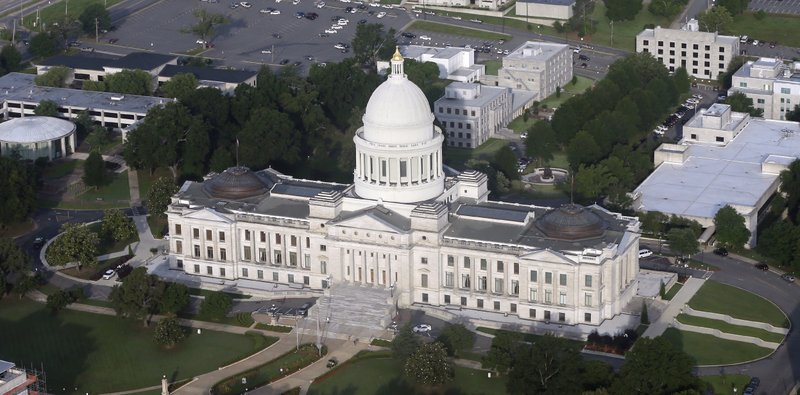The trustees for the Arkansas Public Employees Retirement System on Thursday tossed around various ideas to counter the effects of a turbulent stock market on investment returns, ranging from raising the rate of salary charged to system members to changing the compounded 3% cost-of-living adjustment paid each year to retirees.
Trustees aim to make final decisions in the next few months about what legislation to propose that would increase the system's revenue and/or reduce its costs. The proposals would be considered in the regular legislative session that starts in January. In the 2019 regular session, most of the trustees' proposals to reduce the system's unfunded liabilities failed to clear the Legislature.
"Hopefully, we can get a lot of these issues developed and maybe approved during our May board meeting," board Chairman Candace Franks said at the conclusion of the trustees' two-hour videoconference over Zoom.
The system's investments were valued at about $8.6 billion as of Wednesday, after starting fiscal 2020 on July 1 valued at $9 billion, said Duncan Baird, the system's executive director. The investments increased in value to $9.5 billion in December, dropped to $7.9 billion by the end of March and rebounded in April, he said after the trustees' meeting.
[CORONAVIRUS: Click here for our complete coverage » arkansasonline.com/coronavirus]
The system's investment return so far in fiscal 2020 is "probably around a minus 5%," Mita Drazilov, an actuary for Gabriel, Roeder, Smith & Co., told the trustees. Fiscal 2020 ends June 30.
The system's target annual return is 7.15%.
Unfunded liabilities totaled $2.39 billion as of June 30, 2019, with a projected payoff period of 24 years. Actuaries often compare the projected payoff period for unfunded liabilities to a mortgage on a house.
The system charges state and local governments 15.32% of their annual payroll, while most of the system's members contribute 5% of their salary.
State and local governments paid $293.5 million into the system in fiscal 2019, while employee members paid $68.2 million, according to a system report.
Increasing the rate charged to employee members to 6% would allow the system to maintain the 15.32% rate charged to state and local governments, even with a minus 5% investment return in fiscal 2020, Drazilov said.
Increasing the rate by 1% of salary would raise about $14 million a year for the system, he estimated.
If the return in fiscal 2020 dropped to minus 10%, the rate charged to state and local governments could possibly have to increase by 2 to 2.5 percentage points over the next five to 10 years to keep the projected payoff period for unfunded liabilities at 30 years, he said.
Drazilov said if the return dropped to minus 15%, the payoff period could eventually reach 130 years if the state and local government contribution didn't change.
Or, with a minus 15% return in fiscal 2020, the rate charged to state and local governments could have to increase eventually to about 19% of salary to keep the projected payoff period within 30 years, he said.
Trustee Andrea Lea, who is the state auditor, asked for financial projections if the system paid a simple 3% cost-of-living adjustment each year to retirees rather than a compounded 3%.
She said she also wants to see a financial analysis showing what if retirees received an annual cost-of-living adjustment based on the consumer price index, with an annual cap of 3%.
Trustee Larry Walther said the consumer price index has been well below 3% each of the past five years.
"The lending rate is virtually zero today and we are paying 3% in [the system as a cost-of-living adjustment. That] seems to be something we need to really think about," said Walther, who is the secretary of the state Department of Finance and Administration.
Lea also requested projections comparing an increase in the current 5% rate charged employee members to either 6% and 7% over two years.
Trustee David Hudson, who is the county judge of Sebastian County, asked for an analysis on increasing the current 5% rate to 6% or 7% by 0.25% a year.
Baird told the trustees that employee members have indicated they are willing to pay more into the system to keep it strong.
"I think that would probably be the first thing to look at, based on the member feedback," he said.
"The other feedback that we received generally is employees like the idea of having a benefit that is structured to benefit long-term employees," Baird said. "When you think of the quasi-vesting period, I think you can look at that as something that rewards long-term service and also may eliminate some of the gaming of a short term of service." The current vesting period is five years of service.
The system bases retirement benefits, in part, on the average of the three highest-paid years of service for a member. The trustees also will review the option of increasing that period to the highest-paid five years of service.
"I think [with] the final average compensation, you might be able to look at it in a similar way that it rewards people that build a career [as a system] member and maybe eliminating some potential gaming of the benefit [by employees] that maybe drop in or out of the system at various points in time," he said.
Metro on 05/01/2020

